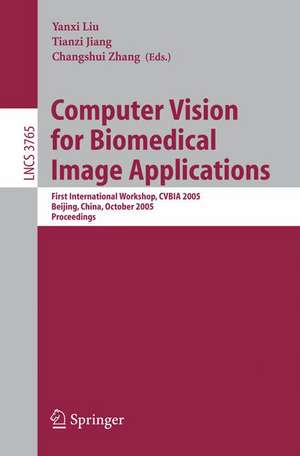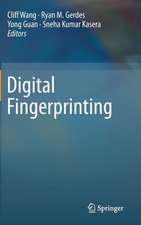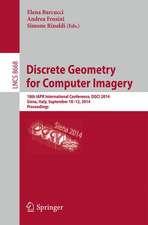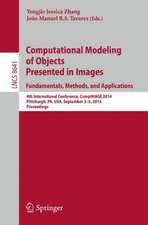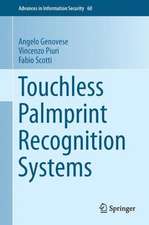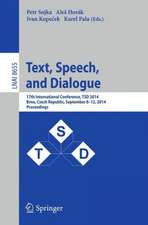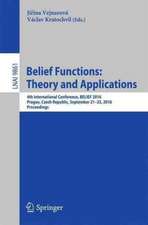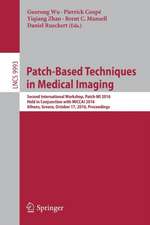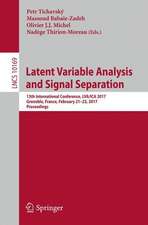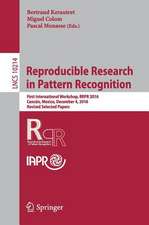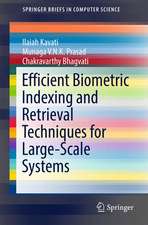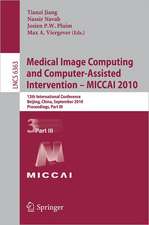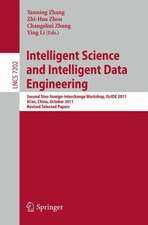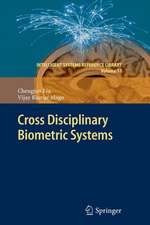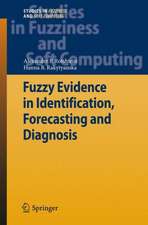Computer Vision for Biomedical Image Applications: First International Workshop, CVBIA 2005, Beijing, China, October 21, 2005, Proceedings: Lecture Notes in Computer Science, cartea 3765
Editat de Yanxi Liu, Tianzi Jiang, Changshui Zhangen Limba Engleză Paperback – 10 oct 2005
Din seria Lecture Notes in Computer Science
- 20%
 Preț: 1061.55 lei
Preț: 1061.55 lei - 20%
 Preț: 307.71 lei
Preț: 307.71 lei - 20%
 Preț: 438.69 lei
Preț: 438.69 lei - 20%
 Preț: 579.30 lei
Preț: 579.30 lei -
 Preț: 410.88 lei
Preț: 410.88 lei - 17%
 Preț: 427.22 lei
Preț: 427.22 lei - 20%
 Preț: 596.46 lei
Preț: 596.46 lei - 15%
 Preț: 448.04 lei
Preț: 448.04 lei - 20%
 Preț: 353.50 lei
Preț: 353.50 lei -
 Preț: 389.49 lei
Preț: 389.49 lei - 20%
 Preț: 309.90 lei
Preț: 309.90 lei - 20%
 Preț: 645.28 lei
Preț: 645.28 lei - 20%
 Preț: 763.23 lei
Preț: 763.23 lei - 15%
 Preț: 580.46 lei
Preț: 580.46 lei - 20%
 Preț: 310.28 lei
Preț: 310.28 lei - 20%
 Preț: 655.02 lei
Preț: 655.02 lei - 20%
 Preț: 1183.14 lei
Preț: 1183.14 lei - 20%
 Preț: 340.32 lei
Preț: 340.32 lei -
 Preț: 449.57 lei
Preț: 449.57 lei - 20%
 Preț: 591.51 lei
Preț: 591.51 lei - 18%
 Preț: 938.83 lei
Preț: 938.83 lei - 20%
 Preț: 337.00 lei
Preț: 337.00 lei - 20%
 Preț: 649.50 lei
Preț: 649.50 lei - 20%
 Preț: 607.40 lei
Preț: 607.40 lei - 20%
 Preț: 1414.79 lei
Preț: 1414.79 lei - 20%
 Preț: 1024.44 lei
Preț: 1024.44 lei - 20%
 Preț: 583.40 lei
Preț: 583.40 lei - 20%
 Preț: 453.32 lei
Preț: 453.32 lei - 20%
 Preț: 575.49 lei
Preț: 575.49 lei - 20%
 Preț: 1075.26 lei
Preț: 1075.26 lei - 20%
 Preț: 585.88 lei
Preț: 585.88 lei - 20%
 Preț: 825.93 lei
Preț: 825.93 lei - 17%
 Preț: 360.20 lei
Preț: 360.20 lei - 20%
 Preț: 763.23 lei
Preț: 763.23 lei - 20%
 Preț: 340.32 lei
Preț: 340.32 lei - 20%
 Preț: 504.58 lei
Preț: 504.58 lei - 20%
 Preț: 369.13 lei
Preț: 369.13 lei - 20%
 Preț: 580.93 lei
Preț: 580.93 lei - 20%
 Preț: 343.62 lei
Preț: 343.62 lei - 20%
 Preț: 350.21 lei
Preț: 350.21 lei - 20%
 Preț: 583.40 lei
Preț: 583.40 lei - 20%
 Preț: 583.40 lei
Preț: 583.40 lei - 15%
 Preț: 438.59 lei
Preț: 438.59 lei - 20%
 Preț: 341.95 lei
Preț: 341.95 lei - 20%
 Preț: 238.01 lei
Preț: 238.01 lei - 20%
 Preț: 538.30 lei
Preț: 538.30 lei
Preț: 659.63 lei
Preț vechi: 824.54 lei
-20% Nou
Puncte Express: 989
Preț estimativ în valută:
126.24€ • 131.31$ • 104.22£
126.24€ • 131.31$ • 104.22£
Carte tipărită la comandă
Livrare economică 12-26 aprilie
Preluare comenzi: 021 569.72.76
Specificații
ISBN-13: 9783540294115
ISBN-10: 3540294112
Pagini: 584
Ilustrații: XIV, 566 p.
Dimensiuni: 155 x 235 x 31 mm
Greutate: 0.81 kg
Ediția:2005
Editura: Springer Berlin, Heidelberg
Colecția Springer
Seriile Lecture Notes in Computer Science, Image Processing, Computer Vision, Pattern Recognition, and Graphics
Locul publicării:Berlin, Heidelberg, Germany
ISBN-10: 3540294112
Pagini: 584
Ilustrații: XIV, 566 p.
Dimensiuni: 155 x 235 x 31 mm
Greutate: 0.81 kg
Ediția:2005
Editura: Springer Berlin, Heidelberg
Colecția Springer
Seriile Lecture Notes in Computer Science, Image Processing, Computer Vision, Pattern Recognition, and Graphics
Locul publicării:Berlin, Heidelberg, Germany
Public țintă
ResearchCuprins
Computational Anatomy and Computational Physiology for Medical Image Analysis.- Analyzing Anatomical Structures: Leveraging Multiple Sources of Knowledge.- Advances on Medical Imaging and Computing.- Tracking of Migrating and Proliferating Cells in Phase-Contrast Microscopy Imagery for Tissue Engineering.- Cardiology Meets Image Analysis: Just an Application or Can Image Analysis Usefully Impact Cardiology Practice?.- Computer Vision Algorithms for Retinal Image Analysis: Current Results and Future Directions.- 3D Statistical Shape Models to Embed Spatial Relationship Information.- A Generalized Level Set Formulation of the Mumford-Shah Functional with Shape Prior for Medical Image Segmentation.- A Hybrid Eulerian-Lagrangian Approach for Thickness, Correspondence, and Gridding of Annular Tissues.- A Hybrid Framework for Image Segmentation Using Probabilistic Integration of Heterogeneous Constraints.- A Learning Framework for the Automatic and Accurate Segmentation of Cardiac Tagged MRI Images.- A Local Adaptive Algorithm for Microaneurysms Detection in Digital Fundus Images.- A New Coarse-to-Fine Framework for 3D Brain MR Image Registration.- A New Vision Approach for Local Spectrum Features in Cervical Images via 2D Method of Geometric Restriction in Frequency Domain.- Active Contours Under Topology Control Genus Preserving Level Sets.- A Novel Multifaceted Virtual Craniofacial Surgery Scheme Using Computer Vision.- A Novel Unsupervised Segmentation Method for MR Brain Images Based on Fuzzy Methods.- A Pattern Classification Approach to Aorta Calcium Scoring in Radiographs.- A Topologically Faithful, Tissue-Guided, Spatially Varying Meshing Strategy for Computing Patient-Specific Head Models for Endoscopic Pituitary Surgery Simulation.- Applying Prior Knowledge in theSegmentation of 3D Complex Anatomic Structures.- Automatic Extraction of Femur Contours from Hip X-Ray Images.- Automatic Landmarking of 2D Medical Shapes Using the Growing Neural Gas Network.- Biomedical Image Classification with Random Subwindows and Decision Trees.- Combining Binary Classifiers for Automatic Cartilage Segmentation in Knee MRI.- Computer-Aided Diagnosis (CAD) for Cervical Cancer Screening and Diagnosis: A New System Design in Medical Image Processing.- Constrained Surface Evolutions for Prostate and Bladder Segmentation in CT Images.- Curvilinear Structure Based Mammographic Registration.- Deformable Registration for Generating Dissection Image of an Intestine from Annular Image Sequence.- Distance-Intensity for Image Registration.- Efficient Population Registration of 3D Data.- Efficient Symbolic Signatures for Classifying Craniosynostosis Skull Deformities.- Elastic Interaction Models for Active Contours and Surfaces.- Estimating Diameters of Pulmonary Nodules with Competition-Diffusion and Robust Ellipsoid Fit.- Fast 3D Brain Segmentation Using Dual-Front Active Contours with Optional User-Interaction.- Improved Motion Correction of fMRI Time-Series Corrupted with Major Head Movement Using Extended Motion-Corrected Independent Component Analysis.- Local or Global Minima: Flexible Dual-Front Active Contours.- Locally Switching Between Cost Functions in Iterative Non-rigid Registration.- Multi-modal Image Registration by Quantitative-Qualitative Measure of Mutual Information (Q-MI).- Multi-scale Vessel Boundary Detection.- Non-rigid Registration for Colorectal Cancer MR Images.- Quantizing Calcification in the Lumbar Aorta on 2-D Lateral X-Ray Images.- Real-Time Simulation of Deformable Soft Tissue Based on Mass-Spring and Medial Representation.- Registration of 3D Angiographic and X-Ray Images Using Sequential Monte Carlo Sampling.- Registration of PET and MR Hand Volumes Using Bayesian Networks.- Segmentation and Volume Representation Based on Spheres for Non-rigid Registration.- Segmentation of 3D CT Volume Images Using a Single 2D Atlas.- Segmenting Brain Tumors with Conditional Random Fields and Support Vector Machines.- Segmenting Cardiopulmonary Images Using Manifold Learning with Level Sets.- Shape Based Segmentation of Anatomical Structures in Magnetic Resonance Images.- Simultaneous Segmentation and Motion Recovery in 3D Cardiac Image Analysis.- Spatial and Temporal Analysis for Optical Imaging Data Using CWT and tICA.- Stereo Matching and 3-D Reconstruction for Optic Disk Images.- Total Variation Based Iterative Image Reconstruction.- Voronoi-Based Segmentation of Cells on Image Manifolds.- Parcellating the Intra-splenium Based on the Traced Fiber from Tractography.- Motion Compensation and Plane Tracking for Kinematic MR-Imaging.
